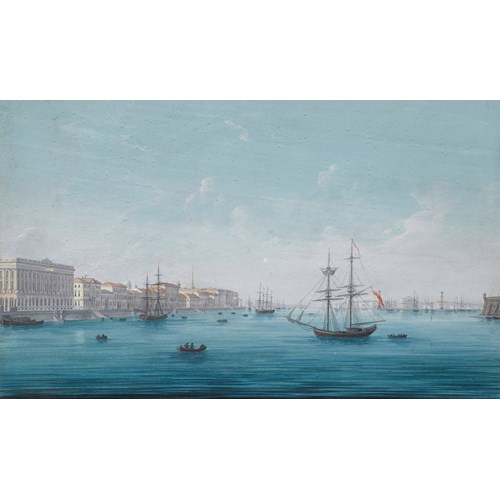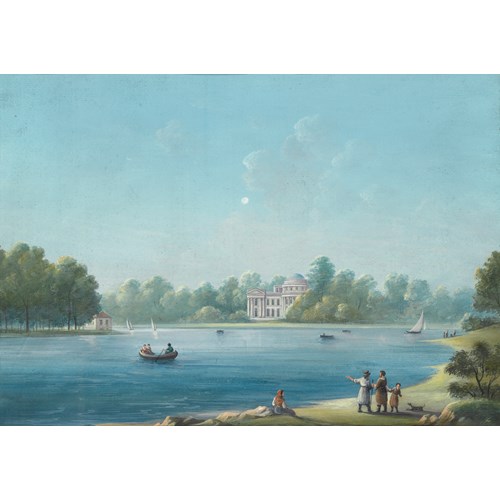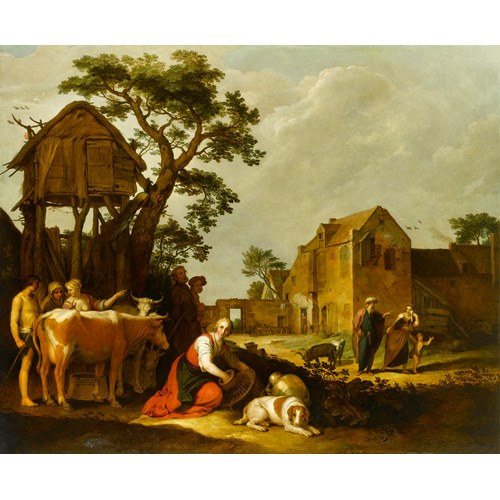Marketplace
View of the Piazza Navona, Rome, with a Commedia dell’Arte performance
Apollonio Facchinetti, called Domenichini, The Master of the Langmatt Foundation Views
View of the Piazza Navona, Rome, with a Commedia dell’Arte performance
View of the Piazza Navona, Rome is a detailed, perspective reproduction of the piazza, seen here from an elevated position from its southern, narrow side. It was built on the site of the 1st century AD Stadium of Domitian and follows the form of the open space of the stadium in an elongated oval. The architecture along the edges of the long piazza consist mainly of baroque buildings. The left row of palaces, starting with the Palazzo Pamphili, stands in the sunlight, interrupted by the facade of the Church of Sant'Agnese in Agone, with its front towers and high dome. The Egyptian obelisk on the Four Rivers Fountain by the sculptor Bernini from 1649 dominates the middle of the square, and to the right in the shaded row of houses is the church of Nostra Signore del Sacro Cuore. A further fountain, the Fontana del Moro, which sits in the foreground has been obscured in this painting by the introduction of a lively group of actors atop a wooden stage conducting a Commedia dell'arte performance, surrounded by a crowded audience and passersby. Other figures, animals, and carriages enliven the square all the way to its northern end.
Domenichini painted the Piazza Navona on numerous occasions, however his Roman oeuvre is only recently coming to light as the establishment of this important painter’s life and work is being studied and his body of work being established. As recently as 2016 Sotheby’s sold a painting of The Arch of Constantine, Rome, by Domenichini, as the only known Roman view by the artist.
The ouevre of Domenichini is derived from a set of thirteen vedute, purchased in the 1920’s by Sidney and Jenny Brown and now kept at the Langmatt Foundation in Baden, Switzerland.1 This homogenous group have been dated c. 1744. The hypothesis that Apollonio Domenichini could be the painter of this large body of finely executed and distinctive vedute, which had collectively been ascribed to ‘The Langmatt Master’, was rigorously debated by scholars of Venetian painting. However, it was only with the discovery by Sphinx Fine Art of a lost inscription to Domenichini on the reverse of an original canvas, hidden under an nineteenth century re-lining of the painting, that it was possible to definitively identify Domenichini as the painter of the Langmatt views. His works have often been misattributed to Canaletto (1697-1768) and his followers. Various scholars, including Succi and Egidio Martini, have posited that Domenichini may have been responsible for these works, on the basis that these Langmatt paintings of significant quality had no known author, and likewise an artist, Domenichini, who was obviously of some importance had no works ascribed to him. However, this suggestion was put forward with reservation, due to its speculative nature, and was not previously universally accepted. During the restoration of a Venetian view by Sphinx Fine Art an old nineteenth-century lining was removed to reveal the inscription which, as Succi has pointed out, is the first time a solid historical reference to the artist had been discovered on a painting. Therefore the known works of the Langmatt Master could, for the first time, be securely given to Domenichini.
Professor Succi first suggested that the Langmatt Master could be associated with the name Apollonio Domenichini.2 Domenichini is registered in the Fraglia (guild) of Venice in 1757,3 but until recently no works bearing his signature remained. We now know that for twenty years Domenichini’s works were sent, via the merchant Giuseppe Maria Sasso, to the English collector John Strange, who was a long time Venetian resident. Details of his life are relatively scarce, however scholars have started to construct a fuller picture through his paintings and various archival sources. From a catalogue of the paintings of Count Bonomo Algarotti, Succi discovered that he was born in Venice in 1715. This catalogue, which was compiled in 1776, makes clear that Domenichini had died, but does not provide specific date.4 He may have been a pupil of Luca Carelvarijs (1663-1730), and his work has been linked by Prof. Succi to the work of Michele Marieschi (1710–1743) and Francesco Albotto (1721–1757). He seems to have been independently active from c.1740, the homogenous group at the Langmatt Foundation have been dated to c.1744 on the basis of architectural details. There is also a work in a private collection, which Succi has identified as being by Domenichini, which is dated ‘ANNO MDCCXXXXVI’ (1746).5
Domenichini painted many of the classic Venetian views that had been popularised by the previous generation of vedutisti, most notably Canaletto. Similarly, Domenichini also painted many Roman works, some of them topographically accurate, and some capricci, which recall the work of Marco Ricci (1676-1730). Many of the qualities and techniques that distinguish Domenichini from his contemporaries become evident here, where there is a slight distortion of perspective, so that the view is broadened to create a more panoramic vista, a trait perhaps resulting from the use of an optical chamber. Due to this aspect, Domenichini’s work has been linked by Succi to the work of Michele Marieschi (1710-1743) and Francesco Albotto (1721-1757), although in general his work seems to have more in common with the Canalettesque works of Francesco Tironi (1745- 1797). Certainly the quality of execution of the vivid and energetic figures is one of the outstanding features of the present work. Prof. Succi and Lino Moretti6 have also discovered that his real surname was Facchinetti. This information derives from the fact that in a document dated August 6, 1702, his father, also a painter, was named as ‘Domenico Facchinetti detto Domenichini’; suggesting that Domenichini was the moniker given to members of the Facchinetti family who were artists.
John Strange was an important and avid collector of paintings, with a particular interest in Venetian painting. In 1773 he was appointed British resident at Venice and he stayed in this diplomatic post until 1788. He then returned to England, and settled at Ridge, near Barnet. However, he continued to travel to Italy, seemingly in order to transport the valuable collections of pictures, books, manuscripts and antiquities, which he had built up. We know from his correspondence with Sasso that he owned many works by Domenichini. This is in fact one reason why Domenichini may not have signed his name, because if he worked for just a few select patrons his signature would have been redundant. This theory, based upon the close relationship between artist and patron, would perhaps explain why the painter did not sign his works. Despite the fact that Strange collected Domenichini’s work over many years, the artist’s name does not appear in his posthumous selling exhibition at the European Museum in 17997, nor at a sale at Christie’s the following year.8 This is understandable given that none of the works would have been signed, and the deceased Strange would not have been able to advise the dealers and auctioneers. Instead, there are numerous works which are attributed to Canaletto, Guardi and others.
We are grateful to Dario Succi for confirming the attribution of the present work to Apollonio Facchinetti, called Domenichini, The Master of the Langmatt Foundation Views.
1 See Mythos Venedig, exh. cat. (Baden, Jun – Oct 1994), pp. 62-117.
2 Succi, D., ‘Apollonio Domenichini: il Maestro della Fondazione Langmatt’ in Da Canaletto a Zuccarelli, exh. cat. (Udine, 2003), pp. 103-7.
3 See Favaro 1975, p. 158.
4 Succi, D. ‘Apollonio Domenichini: il “Maestro della Fondazione Langmatt”, in Da Canaletto a Zuccarelli: Il Paesaggio Veneto del Settecento, exh. cat. (Tavagnacco, 2003).
5 Ibid., p. 106, fig. 77.
6 See L. Moretti, 'Di Apollonio Facchinetti detto Domenichini [1715–1757] e altri pittori di quella famiglia', in: Arte Veneta, 68, pp. 319-323.
7 See European Museum, London, 27th May 1799 (Lugt 5924a); and Christie’s, London, 15th March 1800 (Lugt 6038).
8 Christie & Manson, A Catalogue of the... Gallery of Pictures... of the Right Hon. Lord Northwick; removed from Connaught Place, 24-26 May 1838, lots 54, 73, 109.
Domenichini painted the Piazza Navona on numerous occasions, however his Roman oeuvre is only recently coming to light as the establishment of this important painter’s life and work is being studied and his body of work being established. As recently as 2016 Sotheby’s sold a painting of The Arch of Constantine, Rome, by Domenichini, as the only known Roman view by the artist.
The ouevre of Domenichini is derived from a set of thirteen vedute, purchased in the 1920’s by Sidney and Jenny Brown and now kept at the Langmatt Foundation in Baden, Switzerland.1 This homogenous group have been dated c. 1744. The hypothesis that Apollonio Domenichini could be the painter of this large body of finely executed and distinctive vedute, which had collectively been ascribed to ‘The Langmatt Master’, was rigorously debated by scholars of Venetian painting. However, it was only with the discovery by Sphinx Fine Art of a lost inscription to Domenichini on the reverse of an original canvas, hidden under an nineteenth century re-lining of the painting, that it was possible to definitively identify Domenichini as the painter of the Langmatt views. His works have often been misattributed to Canaletto (1697-1768) and his followers. Various scholars, including Succi and Egidio Martini, have posited that Domenichini may have been responsible for these works, on the basis that these Langmatt paintings of significant quality had no known author, and likewise an artist, Domenichini, who was obviously of some importance had no works ascribed to him. However, this suggestion was put forward with reservation, due to its speculative nature, and was not previously universally accepted. During the restoration of a Venetian view by Sphinx Fine Art an old nineteenth-century lining was removed to reveal the inscription which, as Succi has pointed out, is the first time a solid historical reference to the artist had been discovered on a painting. Therefore the known works of the Langmatt Master could, for the first time, be securely given to Domenichini.
Professor Succi first suggested that the Langmatt Master could be associated with the name Apollonio Domenichini.2 Domenichini is registered in the Fraglia (guild) of Venice in 1757,3 but until recently no works bearing his signature remained. We now know that for twenty years Domenichini’s works were sent, via the merchant Giuseppe Maria Sasso, to the English collector John Strange, who was a long time Venetian resident. Details of his life are relatively scarce, however scholars have started to construct a fuller picture through his paintings and various archival sources. From a catalogue of the paintings of Count Bonomo Algarotti, Succi discovered that he was born in Venice in 1715. This catalogue, which was compiled in 1776, makes clear that Domenichini had died, but does not provide specific date.4 He may have been a pupil of Luca Carelvarijs (1663-1730), and his work has been linked by Prof. Succi to the work of Michele Marieschi (1710–1743) and Francesco Albotto (1721–1757). He seems to have been independently active from c.1740, the homogenous group at the Langmatt Foundation have been dated to c.1744 on the basis of architectural details. There is also a work in a private collection, which Succi has identified as being by Domenichini, which is dated ‘ANNO MDCCXXXXVI’ (1746).5
Domenichini painted many of the classic Venetian views that had been popularised by the previous generation of vedutisti, most notably Canaletto. Similarly, Domenichini also painted many Roman works, some of them topographically accurate, and some capricci, which recall the work of Marco Ricci (1676-1730). Many of the qualities and techniques that distinguish Domenichini from his contemporaries become evident here, where there is a slight distortion of perspective, so that the view is broadened to create a more panoramic vista, a trait perhaps resulting from the use of an optical chamber. Due to this aspect, Domenichini’s work has been linked by Succi to the work of Michele Marieschi (1710-1743) and Francesco Albotto (1721-1757), although in general his work seems to have more in common with the Canalettesque works of Francesco Tironi (1745- 1797). Certainly the quality of execution of the vivid and energetic figures is one of the outstanding features of the present work. Prof. Succi and Lino Moretti6 have also discovered that his real surname was Facchinetti. This information derives from the fact that in a document dated August 6, 1702, his father, also a painter, was named as ‘Domenico Facchinetti detto Domenichini’; suggesting that Domenichini was the moniker given to members of the Facchinetti family who were artists.
John Strange was an important and avid collector of paintings, with a particular interest in Venetian painting. In 1773 he was appointed British resident at Venice and he stayed in this diplomatic post until 1788. He then returned to England, and settled at Ridge, near Barnet. However, he continued to travel to Italy, seemingly in order to transport the valuable collections of pictures, books, manuscripts and antiquities, which he had built up. We know from his correspondence with Sasso that he owned many works by Domenichini. This is in fact one reason why Domenichini may not have signed his name, because if he worked for just a few select patrons his signature would have been redundant. This theory, based upon the close relationship between artist and patron, would perhaps explain why the painter did not sign his works. Despite the fact that Strange collected Domenichini’s work over many years, the artist’s name does not appear in his posthumous selling exhibition at the European Museum in 17997, nor at a sale at Christie’s the following year.8 This is understandable given that none of the works would have been signed, and the deceased Strange would not have been able to advise the dealers and auctioneers. Instead, there are numerous works which are attributed to Canaletto, Guardi and others.
We are grateful to Dario Succi for confirming the attribution of the present work to Apollonio Facchinetti, called Domenichini, The Master of the Langmatt Foundation Views.
1 See Mythos Venedig, exh. cat. (Baden, Jun – Oct 1994), pp. 62-117.
2 Succi, D., ‘Apollonio Domenichini: il Maestro della Fondazione Langmatt’ in Da Canaletto a Zuccarelli, exh. cat. (Udine, 2003), pp. 103-7.
3 See Favaro 1975, p. 158.
4 Succi, D. ‘Apollonio Domenichini: il “Maestro della Fondazione Langmatt”, in Da Canaletto a Zuccarelli: Il Paesaggio Veneto del Settecento, exh. cat. (Tavagnacco, 2003).
5 Ibid., p. 106, fig. 77.
6 See L. Moretti, 'Di Apollonio Facchinetti detto Domenichini [1715–1757] e altri pittori di quella famiglia', in: Arte Veneta, 68, pp. 319-323.
7 See European Museum, London, 27th May 1799 (Lugt 5924a); and Christie’s, London, 15th March 1800 (Lugt 6038).
8 Christie & Manson, A Catalogue of the... Gallery of Pictures... of the Right Hon. Lord Northwick; removed from Connaught Place, 24-26 May 1838, lots 54, 73, 109.
Provenance: The Collection of Sir Arthur Wilmot, 7th Bt. (1909-42);
by descent to the previous owner.
Plus d'œuvres d'art de la Galerie









